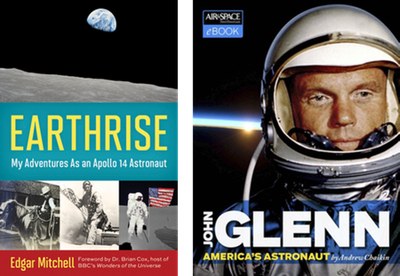Reviews: new spins on astronaut biographiesby Jeff Foust
|
| Mitchell doesn’t shy away from discussing his interest in ESP in the book, writing about his ESP experiments he performed during Apollo 14, and pursuing that interest after leaving the astronaut corps. |
Edgar Mitchell, the lunar module pilot on Apollo 14, revisits his life and career in a new memoir, Earthrise. This is not the first book he’s written about his career—he authored The Way of the Explorer in 1996—but this book is targeted specifically at “young adult” audiences, ages 12 and up. It is, though, a book that can be read and appreciated by teens and adults alike, as Mitchell describes his path to becoming an astronaut and his exploration of the Moon on Apollo 14 with Shepard.
After an attention-grabbing introduction—the abort signal he and Shepard saw on the lunar module’s control panel as they prepared to descend to the surface—Mitchell then provides a fairly straightforward, chronological account of his life: growing up in New Mexico, going to college at Carnegie Tech (now Carnegie Mellon University), becoming a Navy pilot, and then an astronaut. Much of the book, not surprisingly, is about the Apollo 14 mission itself.
Since Apollo 11, Mitchell has become better known—or, in some circles, infamous—for his interest in extrasensory perception (ESP) and other paranormal phenomena. He doesn’t shy away from discussing them in the book, writing about his ESP experiments he performed during Apollo 14, and pursuing that interest after leaving the astronaut corps. However, he doesn’t go into a lot of detail on those topics, or much else about his life after the mission.
An astronaut whose life story has been told even more often than Mitchell’s is that of John Glenn, the first American to orbit the Earth. His career, from wartime pilot to astronaut to politician to his return to space on the shuttle in 1998, has been told many times, including in his own 1999 autobiography, John Glenn: A Memoir. In John Glenn: America’s Astronaut, spaceflight historian Andrew Chaikin provides his own, brief take on the life of the last surviving member of the Mercury Seven.
The book, in many respects, seeks to answer a question Chaikin poses in the preface: “what is it about Glenn that has won him an enduring place of honor in the life of a nation?” The answer, Chaikin argues, is that Glenn “stands as a living emblem of the American Century.” Chaikin backs up that assertion with a chronological account of Glenn’s life and service to the nation. Much of the book, not surprisingly, is about Glenn’s flights on Friendship 7 in 1962 and STS-95 in 1998, but it also covers his life before, in between, and after those flights, including his challenges as a politician: “the very traits that made him appealing as a national hero,” Chaikin notes, “worked against him when it came time to woo supporters.”
| “What is it about Glenn that has won him an enduring place of honor in the life of a nation?” The answer, Chaikin argues, is that Glenn “stands as a living emblem of the American Century.” |
John Glenn: America’s Astronaut is released as an ebook, and it takes advantage of the multimedia capabilities of the medium. The book includes a large number of photos as well as two videos. (Watching the videos requires reading the ebook on a tablet or similar device, like an iPad; the video won’t work on some dedicated ebook readers.) One of the videos is part of a post-flight presentation Glenn made after the STS-95 mission, including comparing views of the Earth from that mission with what he saw on his Mercury flight. The other, created by Chaikin for the book, syncs the silent 16mm film of Glenn inside the Mercury capsule during reentry with the audio of Glenn’s communications with ground controllers. That alone is a fascinating look at a dramatic point in the mission, with Glenn being instructed by controllers to leave his retrothrusters in place during reentry, without initially being told why.
Neither Earthrise nor John Glenn: America’s Astronaut break much in the way of new ground about the lives of the astronauts they profile. Both, though, summarize those lives well in relatively brief forms, tailored for newer formats or audiences. As the early Space Age becomes more of an historical event rather than a shared experience, these books help keep the accomplishments of those astronauts, and that era, alive for new generations.
